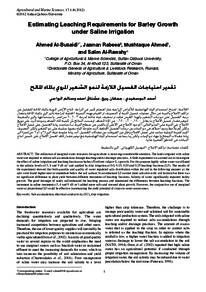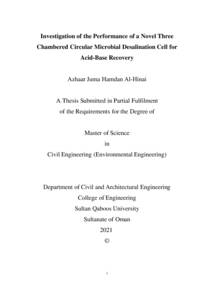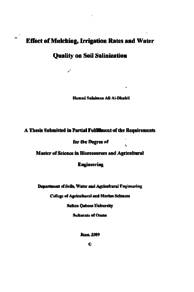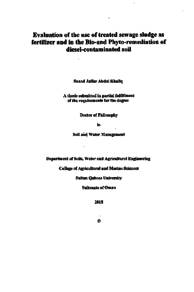وثيقة
Porous-tube subsurface irrigation.
الناشر
Sultan Qaboos university
ميلادي
1998
اللغة
الأنجليزية
الملخص الإنجليزي
This research was conducted to study the factors leading to the uniform distribution of water from a subsurface irrigation system using porous lubes. The factors included the depth at which the tubes are installed, operating pressure, depth of impermeable layer, and a gravel envelope surrounding the tubes. A laboratory soil tank was constructed to determine the effect of these factors. The tank was filled with sand and fitted with porous tubes. The tank and the tubes represent a section of soil profile. The results of this study showed that the depth of the impermeable layer affected significantly the water-table rise in the soil profile. The gravel envelope did not show any advantage over tubes without an envelope in sandy soils. A separate experiment was conducted to compare the characteristics of the flow from the porous tubes with the specifications given by the manufacturer. The results of the experiment showed that porous tubes do not work efficiently either under low pressure (below 80 kPa) or very high pressure (i.e. above 150 kPa).
المجموعة
ISSN
2410-1079
URL المصدر
zcustom_txt_2
Mohammad, F. S. (1998). Porous-tube subsurface irrigation. Journal of Agricultural and Marian Sciences, 3 (2), 49-57.
الملخص العربي
أجري هذا البحث لدراسة العوامل التي تؤدي إلى التوزيع المنتظم للماء تحت سطح التربة عند استخدام الأنابيب المسامية. تشمل هذه العوامل عمق الأنابيب وشدة الضغط المشغل لنظام الري وعمق طبقة الأرض غير النفاذة والغلاف الحصوي المحيط بالأنبوب. ولتحديد مدى تأثير هذه العوامل مختبريا أنشئ خزان وتم ملؤه بالرمل ووضع بداخله الأنابيب المسامية، ويمثل الخزان والأنابيب وضعا مقطعا داخل التربة. وأوضحت النتائج أن عمق الطبقة غير النفاذة يؤثر تأثيرا واضحا في ارتفاع مستوى الماء. ولم يكن للغلاف الحصوي أي أفضلية على الأنابيب المسامية غير المغلفة. وقد دلت التجارب إلى أن هذه الأنابيب لا تعمل بكفاءة في حالة الضغط المنخفض (أقل من 80 كيلو بسكال) أو المرتفع جدا (أكثر من 150كيلو باسكال).
قالب العنصر
مقالات الدوريات







